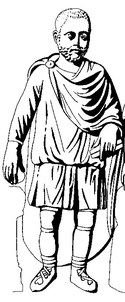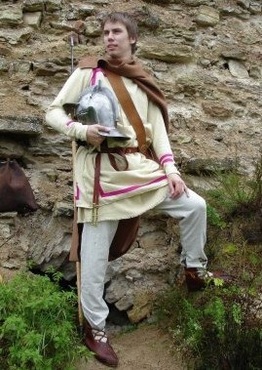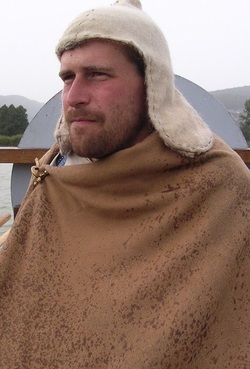CLOTHING
|
What did the Roman soldier in 200 or 220AD wear? You will be familiar with the short sleeved tunic worn by most men in the 1st century. Romans at the time hated trousers and considered them 'barbaric'. But as the soldiers of Rome spent years and years fighting German tribes on the Rhine and Danube frontier, they began to wear the local style of clothing. More Germans were joining the legions and even the emperors started to wear the long sleeved tunics and long trousers of the local people! The emperor wanted to look like he was a soldier to gain the trust and friendship of his troops.
When emperor Septimus Severus brought troops into Rome from the Danube frontier [193 AD] the people of Rome were horrified to see that the Roman legionaries were dressing like barbarians! It was a custom that seemed to go back to the mid 2nd century, several tombstones in the late 2nd century illustrated soldiers wearing this barbarian garb. So forget bare arms and bare legs. Soldiers of 200AD dress like the locals, and its a style of clothing more suited to the cold forests and mountains of Germany and northern Britain.. Romans continued to dress like this for another 400 years! |
Above Left Denis Gvozdikov of St. Petersburg wears a long-sleeved tunic with applied pink/purple decoration based on those depicted in the Terentius fresco, The troops in that fresco were members of Twentieth Cohort of Palmyrenes, based at Dura Europus in the early 3rd century. He wears enclosed calcei boots and thin woollen trousers.
Above Right Florian Himmler, member of the III Italica re-enacment group based in Regensburg, weathers rain on the Danube. He wears a brown sagum pinned with a crossbow brooch, a brooch type that gained popularity in the 3rd century, and became almost universal for imperial personnel in the 4th century. He also wears a Phrygian cap, popular with soldiers, a version was found at Dura Europus that served as an arming cap.
Above Right Florian Himmler, member of the III Italica re-enacment group based in Regensburg, weathers rain on the Danube. He wears a brown sagum pinned with a crossbow brooch, a brooch type that gained popularity in the 3rd century, and became almost universal for imperial personnel in the 4th century. He also wears a Phrygian cap, popular with soldiers, a version was found at Dura Europus that served as an arming cap.



